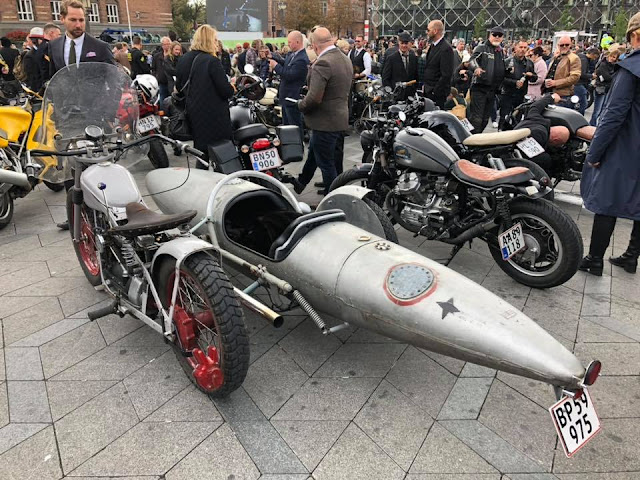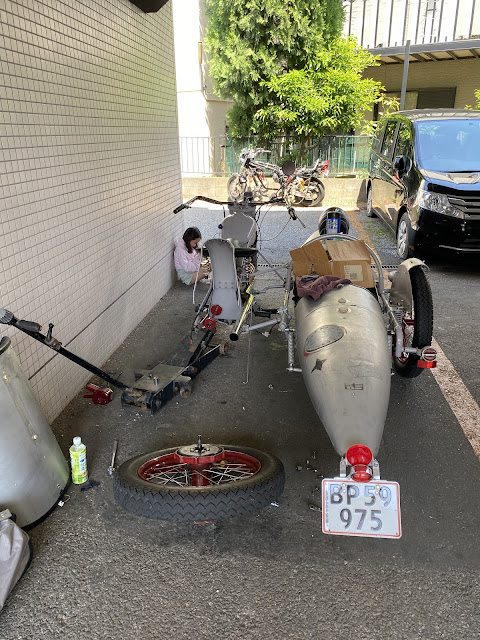Motorheads and Tea Ceremony
June 3, 2023
Start out like yesterday with Naga-san picking me up, criss-cross for 35 minutes through the maze of residential roads while talking about how he started out on a Velo Solex, the little French contraption with an engine on top of the front wheel. And about how the building code requires new houses here to have solar panels. And how many traffic lights there are in Tokyo (Naga-san doesn't know, and neither does The Internets, but Japan has 208,000+ in total.) The translator gadget makes the conversation manageable, albeit with much cursing when its interpretations of our words get the better of it.
Eventually we make it to 'Batcycle', a company dealing primarily with small almost forgotten brands of Italian motorcycles. Anybody remember Rumi, Beta, Motobi, Caproni, Gilera, Parilla or Mondial? Ok nerds, you did, but the WM R1-GOO or the French Monet Croyon? Owner Tsuneto Katayame, one of the two or three top specialists over here when it comes to Italian bikes, obviously has a yen for them. Add to this the odd Soviet scooter or hand gear change Jupiter.
Star of the collection is a Suzuki Katana, much modified with fibreglass parts by an Italian company. Well, 'star' may be too big a word, because the original Hans Muth designed Katana was already in a league of its own as far as radical AND marketable design went. I'll just suggest this version is sort of interesting mainly because I've never heard of it. I'm jaded of course, but also get very excited when ultra rare stuff appears in the far end of the world.
Also interesting in a scrap sort of way are the remnants of a Daimler Benz airplane engine, that once powered a Messerschmitt 109 fighter flying over England during WW2. It met its maker - figuratively speaking, of course - there, and was dug out of the ground some 35 years ago and sent to Tokyo. When first seeing it on my way to the second level room with all them bikes, I was wondering what kind of mechanical mishap could bend a crankshaft and cylinders that bad. A 300mph+ crash obviously could.
Next stop another 35 minutes away is at Harley and Rikuo affeciando Funabahi-san, whom I met when the solo Nimbus was out racing on Fuji Speedway. Apparently both of us are easy to recognize again, as far as I'm concerned because I remember him as an untypically tall, skinny guy. His garage has two pre-war Harley sidecar bikes, and two Rikuos, the Japanese versions built under license. One of the latter is military, and the other a very impressive civilian version made 9 years after the Second World Misunderstanding. It remained a side valve version with springer front end, seemingly very little different from the first version from the thirties.
Funabashi-san, a carpenter by trade and famous in the classic motorcycle circles here, does all the work on the bikes himself, save for the chroming. He also made the woodwork on all the many houses in all of the neighborhood's houses, he says. At his workshop near the garage his one-owner 1969 Honda CB750 stands next to what looks like a bike being built, but which is his test stand for engines. A pulley lifts bikes through a hole in the ceiling up to the next level, where the paint booth can be found. More parts and stuff up there too, of course, and on the wall a picture of his famous-at-least-in-Japan Norton 'Featherbed' framed, twin engine, four cylinder Honda racer.
Last stops are in Nishi-Kawaguchi, for Naga-san to take pictures of the Nimbus, to be used in his web article. Some neighbors show up while we're shooting, and - clearly impressd with the eight moving rocker arms - end up inviting us for the famous Japanese tea ceremony, a hitherto unknown, but very nice experience for me. Thanks guys, I love it when that sort of surprises happen, and thanks for the gifts.
Then dinner at Ohira-san's worksop and finally me holding my breath when entering the cheap hotel next to the train station. It is fine, though, the mere three buttons operating the toilet seat features nicely correlating to the price of a stay. Honest, the more expensive a hotel, the more buttons you get.















Kommentarer
Send en kommentar